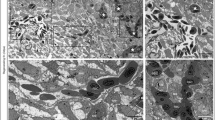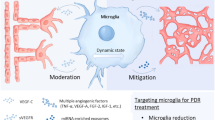Abstract
The hyaloid vessel is a transient vascular network that nourishes the lens and the primary vitreous in the early developmental periods. In hyaloid vessels devoid of the support of astrocytes, we demonstrate that tight junction proteins, zonula occludens-1 and occludin, are regularly expressed at the junction of endothelial cells. To figure out the factor influencing the formation of tight junctions in hyaloid vessels, we further progress to investigate the interactions between endothelial cells and pericytes, two representative constituent cells in hyaloid vessels. Interestingly, endothelial cells interact with pericytes in the early postnatal periods and the interaction between two cell types provokes the up-regulation of transforming growth factor β1. Further in vitro experiments demonstrate that transforming growth factor β1 induces the activation of Smad2 and Smad3 and the formation of tight junction proteins. Taken together, in hyaloid vessels, pericytes seem to regulate the formation of tight junctions by the interaction with endothelial cells even without the support of astrocytes. Additionally, we suggest that the hyaloid vessel is a valuable system that can be utilized for the investigation of cell-cell interaction in the formation of tight junctions in developing vasculatures.
Similar content being viewed by others
References
Abbott, N.J., Patabendige, A.A., Dolman, D.E., Yusof, S.R., and Begley, D.J. (2010). Structure and function of the blood-brain barrier. Neurobiol. Dis. 37, 13–25.
Antonetti, D.A., Barber, A.J., Hollinger, L.A., Wolpert, E.B., and Gardner, T.W. (1999). Vascular endothelial growth factor induces rapid phosphorylation of tight junction proteins occludin and zonula occluden 1. A potential mechanism for vascular permeability in diabetic retinopathy and tumors. J. Biol. Chem. 274, 23463–23467.
Armulik, A., Genove, G., Mae, M., Nisancioglu, M.H., Wallgard, E., Niaudet, C., He, L., Norlin, J., Lindblom, P., Strittmatter, K., et al. (2010). Pericytes regulate the blood-brain barrier. Nature 468, 557–561.
Bjarnegard, M., Enge, M., Norlin, J., Gustafsdottir, S., Fredriksson, S., Abramsson, A., Takemoto, M., Gustafsson, E., Fassler, R., and Betsholtz, C. (2004). Endothelium-specific ablation of PDGFB leads to pericyte loss and glomerular, cardiac and placental abnormalities. Development 131, 1847–1857.
Brown, A.S., Leamen, L., Cucevic, V., and Foster, F.S. (2005). Quantitation of hemodynamic function during developmental vascular regression in the mouse eye. Invest. Ophthalmol. Vis. Sci. 46, 2231–2237.
Daneman, R., Zhou, L., Kebede, A.A., and Barres, B.A. (2010). Pericytes are required for blood-brain barrier integrity during embryogenesis. Nature 468, 562–566.
Dohgu, S., Yamauchi, A., Takata, F., Naito, M., Tsuruo, T., Higuchi, S., Sawada, Y., and Kataoka, Y. (2004). Transforming growth factor-beta1 upregulates the tight junction and P-glycoprotein of brain microvascular endothelial cells. Cell. Mol. Neurobiol. 24, 491–497.
Dohgu, S., Takata, F., Yamauchi, A., Nakagawa, S., Egawa, T., Naito, M., Tsuruo, T., Sawada, Y., Niwa, M., and Kataoka, Y. (2005). Brain pericytes contribute to the induction and up-regulation of blood-brain barrier functions through transforming growth factorbeta production. Brain Res. 1038, 208–215.
Garcia, C.M., Darland, D.C., Massingham, L.J., and D’Amore, P.A. (2004). Endothelial cell-astrocyte interactions and TGF beta are required for induction of blood-neural barrier properties. Brain Res. Dev. Brain Res. 152, 25–38.
Hahn, P., Lindsten, T., Tolentino, M., Thompson, C.B., Bennett, J., and Dunaief, J.L. (2005). Persistent fetal ocular vasculature in mice deficient in bax and bak. Arch. Ophthalmol. 123, 797–802.
Hamming, N.A., Apple, D.J., Gieser, D.K., and Vygantas, C.M. (1977). Ultrastructure of the hyaloid vasculature in primates. Invest. Ophthalmol. Vis. Sci. 16, 408–415.
Ito, M., and Yoshioka, M. (1999). Regression of the hyaloid vessels and pupillary membrane of the mouse. Anat. Embryol. 200, 403–411.
Kim, J.H., Park, J.A., Lee, S.W., Kim, W.J., Yu, Y.S., and Kim, K.W. (2006). Blood-neural barrier: intercellular communication at gliovascular interface. J. Biochem. Mol. Biol. 39, 339–345.
Kim, J.H., Yu, Y.S., Kim, K.W., and Min, B.H. (2007). The role of clusterin in in vitro ischemia of human retinal endothelial cells. Curr. Eye Res. 32, 693–698.
Kim, J.H., Yu, Y.S., Kim, D.H., and Kim, K.W. (2009a). Recruitment of pericytes and astrocytes is closely related to the formation of tight junction in developing retinal vessels. J. Neurosci. Res. 87, 653–659.
Kim, J.H., Lee, Y.M., Ahn, E.M., Kim, K.W., and Yu, Y.S. (2009b). Decursin inhibits VEGF-mediated inner blood-retinal barrier breakdown by suppression of VEGFR-2 activation. J. Cereb. Blood Flow Metab. 29, 1559–1567.
Kim, J.H., Yu, Y.S., Mun, J.Y., and Kim, K.W. (2010a). Autophagyinduced regression of hyaloid vessels in early ocular development. Autophagy 6, 922–928.
Kim, J.H., Yu, Y.S., Min, B.H., and Kim, K.W. (2010b). Protective effect of clusterin on blood-retinal barrier breakdown in diabetic retinopathy. Invest. Ophthalmol. Vis. Sci. 51, 1659–1665.
Kim, J.H., Yu, Y.S., Kim, K.W., and Kim, J.H. (2011). Investigation of barrier characteristics in the hyaloid-retinal vessel of zebrafish. J. Neurosci. Res. 89, 921–928.
Koto, T., Takubo, K., Ishida, S., Shinoda, H., Inoue, M., Tsubota, K., Okada, Y., and Ikeda, E. (2007). Hypoxia disrupts the barrier function of neural blood vessels through changes in the expression of claudin-5 in endothelial cells. Am. J. Pathol. 170, 1389–1397.
Lang, R.A., and Bishop, J.M. (1993). Macrophages are required for cell death and tissue remodeling in the developing mouse eye. Cell 74, 453–462.
Lee, S.M., and Yu, Y.S. (2004). Outcome of hyperplastic persistent pupillary membrane. J. Pediatr. Ophthalmol. Strabismus 41, 163–171.
Lindahl, P., Johansson, B.R., Leveen, P., and Betsholtz, C. (1997). Pericyte loss and microaneurysm formation in PDGF-B-deficient mice. Science 277, 242–245.
Ling, T.L., and Stone, J. (1988). The development of astrocytes in the cat retina: evidence of migration from the optic nerve. Brain Res. Dev. Brain Res. 44, 73–85.
McLeod, D.S., Hasegawa, T., Baba, T., Grebe, R., Galtier d’Auriac, I., Merges, C., Edwards, M., and Lutty, G.A. (2012). From blood islands to blood vessels: morphologic observations and expression of key molecules during hyaloid vascular system development. Invest. Ophthalmol. Vis. Sci. 53, 7912–7927.
Ozerdem, U., Grako, K.A., Dahlin-Huppe, K., Monosov, E., and Stallcup, W.B. (2001). NG2 proteoglycan is expressed exclusively by mural cells during vascular morphogenesis. Dev. Dyn. 222, 218–227.
Saint-Geniez, M., and D’Amore, P.A. (2004). Development and pathology of the hyaloid, choroidal and retinal vasculature. Int. J. Dev. Biol. 48, 1045–1058.
Tallquist, M.D., French, W.J., and Soriano, P. (2003). Additive effects of PDGF receptor beta signaling pathways in vascular smooth muscle cell development. PLoS Biol. 1, E52.
Walshe, T.E., Saint-Geniez, M., Maharaj, A.S., Sekiyama, E., Maldonado, A.E., and D’Amore, P.A. (2009). TGF-beta is required for vascular barrier function, endothelial survival and homeostasis of the adult microvasculature. PLoS One 4, e5149.
Zhu, M., Provis, J.M., and Penfold, P.L. (1999). The human hyaloid system: cellular phenotypes and inter-relationships. Exp. Eye Res. 68, 553–563.
Author information
Authors and Affiliations
Corresponding authors
About this article
Cite this article
Jo, D.H., Kim, J.H., Heo, JI. et al. Interaction between pericytes and endothelial cells leads to formation of tight junction in hyaloid vessels. Mol Cells 36, 465–471 (2013). https://doi.org/10.1007/s10059-013-0228-1
Received:
Revised:
Accepted:
Published:
Issue Date:
DOI: https://doi.org/10.1007/s10059-013-0228-1




